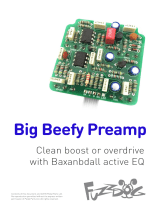Page is loading ...

Bosstone
Clone of an all-time
classic fuzz by Jordan
Contents of this document are ©2015 Pedal Parts Ltd.
No reproduction permitted without the express written
permission of Pedal Parts Ltd. All rights reserved.

Schematic
BOM
R1 150K
R2 560K
R3 560K
R4 18K
R5 18K
R6 2K2 (CLR)
R7 Ignore
C1 22n
C2 22n
C3 47p
C4 22n
D1,2 1N4148
D3,4 *
Q1 2n2222
Q2 2n3906
ATTACK 100KB
VOL 100KA
SWITCH SPDT
*Extra spots have been added for a second set of clipping diodes.
These are optional, but experimentation is fun. Try germaniums or LEDs.
See later in the doc for info about the switching.

The power and signal pads on the PCB conform to the FuzzDog Direct Connection
format, so can be paired with the appropriate daughterboard for quick and easy
offboard wiring.
Be very careful when soldering the diodes and transistors. They’re very sensitive
to heat. You should use some kind of heat sink (crocodile clip or reverse action
tweezers) on each leg as you solder them. Keep exposure to heat to a minimum
(under 2 seconds).
Snap the small metal tag off the pots so they can be mounted flush in the box.
Pot mounts on the back side of the board. You can use vertical-mount pots or just wire up ‘normal’ ones.
The striped leg (cathode) of the diodes go into the square pads.
The long leg (anode) of the electrolytic capacitors go into the square pads.
D3 and D4 are optional. To build the circuit in stock format with fixed clipping, leave these out and put a
jumper wire between pads S1 and S2.
To add the optional clipping switch, populate D3 and D4 with
your choice of diode (1N34 work well), and add your selection
switch. This can be a standard SPDT ON-ON toggle switch, or a
micro toggle as shown, which should locate nicely into the pads
provided. This can go either side of the PCB, depending how far
you want your switch from your knobs.
For extra fun you could make this a SPDT ON-OFF-ON switch.
The middle position will take out the clipping altogether, giving
you a very loud overdrive effect. The top two pads above the S1-3
pads are just location holes for the micro toggle. Nothing
connects to these.
PCB Layout ©2014 Pedal Parts Ltd.
1 2 3
Bottom of a standard toggle switch
<<<<<<

Test the board!
UNDER NO CIRCUMSTANCES will troubleshooting help
be offered if you have skipped this stage. No exceptions.
Once you’ve finished the circuit it makes sense to test is before
starting on the switch and LED wiring. It’ll cut down
troubleshooting time in the long run. If the circuit works at this
stage, but it doesn’t once you wire up the switch - guess what?
You’ve probably made a mistake with the switch.
Solder some nice, long lengths of wire to the board connections for
9V, GND, IN and OUT. Connect IN and OUT to the jacks as shown.
Connect all the GNDs together (twist them up and add a small
amount of solder to tack it). Connect the battery + lead to the 9V
wire, same method. Plug in. Go!
If it works, crack on and do your switch wiring. If not... aw man.
At least you know the problem is with the circuit. Find out why, get
it working, THEN worry about the switch etc.
UO
YRET
T
A
AT
B
NI
TU
GND
9V
IN
S
T
UDING WIRED PO
INCL
cuit boa
w cir
e, ne
our nic
Y
o
NI
OUT
!!!!
d
ar
TUO

(if using a daughterboard please refer to the relevant document)
Wire it up - with battery
This circuit is standard, Negative GND. Your power supply should be
Tip Negative / Sleeve Positive. That’s the same as your standard pedals
(Boss etc), and you can safely daisy-chain your supply to this pedal.
The BOARD GND connections don’t all have to connect to one point. They
can be daisy-chained around the circuit, using larger connection points
(such as jack socket lugs) for multiple connections. As long as they all
connect together in some way.
L
E
D
BOARD
OUT
BOARD
9V
BOARD
GND
BOARD
GND
BOARD
GND
BOARD
INPUT
BATTERY
+
IN
OUT
L
E
D
BOARD
GND
BOARD
LED+
+

(if using a daughterboard please refer to the relevant document)
Wire it up - DC only version
This circuit is standard, Negative GND. Your power supply should be
Tip Negative / Sleeve Positive. That’s the same as your standard pedals
(Boss etc), and you can safely daisy-chain your supply to this pedal.
The BOARD GND connections don’t all have to connect to one point. They
can be daisy-chained around the circuit, using larger connection points
(such as jack socket lugs) for multiple connections. As long as they all
connect together in some way.
PedalParts.co.uk
L
E
D
BOARD
OUT
BOARD
9V
BOARD
GND
BOARD
GND
BOARD
GND
BOARD
INPUT
+
IN
OUT
L
E
D
BOARD
GND
BOARD
LED+
/









